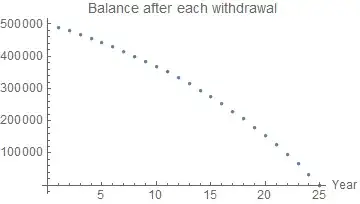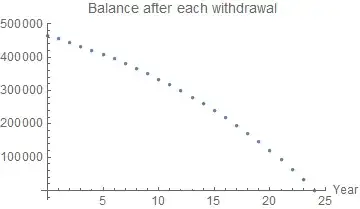The way the question is written, the answer is that your withdrawal rate must be whatever the constant growth rate of the account is. In other words, if your account is worth $100 and makes 5% each year, you can safely withdraw $5, or about 4.762%, of the EOY balance (or 5% of the BOY balance) each year perpetually.
However, you what you probably mean to ask is what the withdrawal amount should be to amortize the account over a given period. The balance B at month m = 0 is B(0) = p0. Assume a monthly interest rate of r and a total number of months M. The balance at month B(m + 1) = r * p0 - X, where X is the monthly withdrawal rate. If we want to exhaust the money after M months then we get B(M) = 0. Let's write out some terms:
m B(m)
---------
0 p0
1 r * p0 - X
2 r * (r * p0 - X) - X = r^2 * p0 - r * X - X
3 r * (r^2 * p0 - r * X - X) - X = r^3 * p0 - r^2 * X - r * X - X
…
k r^k * p0 - X * (r^(k-1) + r^(k-2) + … + 1)
We can use the partial sum formula to simplify the sum of powers of r to get:
B(k) = r^k * p0 - X * (r^k - 1) / (r - 1)
When k = M we require that B(k) = 0:
B(M) = r^M * p0 - X * (r^M - 1) / (r - 1) = 0
r^M * p0 = X * (r^M - 1) / (r - 1)
r^M * p0 * (r - 1) / (r^M - 1) = X
So, if p0 = $100k, r = 5% per year = 1.004074 and M = 240 (20 years), then the monthly withdrawal rate is:
X = 2.653219 * $100k * (0.004074) / (1.653219)
~ $653.82
This is basically the same way mortgage amortization is done. Note that this is taking out the same payment but different percentages, which is probably a lot closer to what you're really looking for.

